Methamphetamine-induced behavioral sensitization in mice: alterations in mu-opioid receptor
- PMID: 16847721
- PMCID: PMC2925105
- DOI: 10.1007/s11373-006-9102-x
Methamphetamine-induced behavioral sensitization in mice: alterations in mu-opioid receptor
Abstract
We had previously demonstrated that opioid receptors contribute to the induction and expression of behavioral sensitization induced by repeated daily injection with 2.5 mg/kg of methamphetamine for 7 days. Using the same regimen, the present study investigated the alterations in mu-opioid receptor during the induction (on days 2, 5, and 8) and expression (on days 11 and 21) periods of behavioral sensitization. Radioligand binding revealed that the maximal binding of mu-opioid receptor was not changed on days 2 and 5, but down-regulated on day 8. After cessation of drug treatment, the maximal binding of mu-opioid receptor gradually and time-dependently returned to normal level on day 11 and up-regulated on day 21. In contrast, no changes in delta- and kappa-opioid receptors were detectable on any given day examined. The potency of DAMGO for [(35)S]-GTPgammaS coupling was enhanced on days 2, 5, 11, and 21. Moreover, 1 muM of naltrexone or beta-chlornaltrexamine significantly suppressed the basal [(35)S]-GTPgammaS coupling on days 2, 11, and 21. These findings indicate enhanced responsiveness and elevated constitutive activity of mu-opioid receptor. In summary, our data clearly demonstrate that alterations in mu-opioid receptor are involved in and may contribute to the sensitization to locomotor stimulating effect of methamphetamine.
Figures
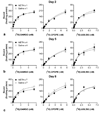

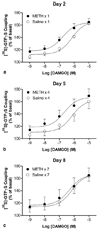

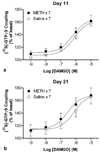
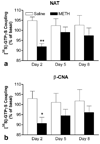
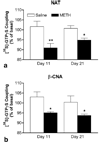
Similar articles
-
Antagonistic property of buprenorphine for putative epsilon-opioid receptor-mediated G-protein activation by beta-endorphin in pons/medulla of the mu-opioid receptor knockout mouse.Neuroscience. 2002;115(3):715-21. doi: 10.1016/s0306-4522(02)00486-4. Neuroscience. 2002. PMID: 12435410
-
Opioid receptor agonists selective for mu and kappa receptors attenuate methamphetamine-induced behavioral sensitization in the mouse.Biol Pharm Bull. 1996 Mar;19(3):369-74. doi: 10.1248/bpb.19.369. Biol Pharm Bull. 1996. PMID: 8924903
-
Comparison of G-protein activation in the brain by mu-, delta-, and kappa-opioid receptor agonists in mu-opioid receptor knockout mice.Brain Res Bull. 2000 Jul 1;52(4):297-302. doi: 10.1016/s0361-9230(00)00265-3. Brain Res Bull. 2000. PMID: 10856828
-
[(35)S]GTPγS binding and opioid tolerance and efficacy in mouse spinal cord.Pharmacol Biochem Behav. 2012 Mar;101(1):155-65. doi: 10.1016/j.pbb.2011.11.001. Epub 2011 Nov 12. Pharmacol Biochem Behav. 2012. PMID: 22108651
-
G protein activation by endomorphins in the mouse periaqueductal gray matter.J Biomed Sci. 2000 May-Jun;7(3):221-5. doi: 10.1007/BF02255469. J Biomed Sci. 2000. PMID: 10810240
Cited by
-
Epigenetic Modulation of Opioid Receptors by Drugs of Abuse.Int J Mol Sci. 2022 Oct 5;23(19):11804. doi: 10.3390/ijms231911804. Int J Mol Sci. 2022. PMID: 36233105 Free PMC article. Review.
-
Alleviation of Methamphetamine Sensitization by Partially Lesioning Dopaminergic Terminals with 6-Hydroxydopamine in Nucleus Accumbens.Cell Transplant. 2021 Jan-Dec;30:9636897211052300. doi: 10.1177/09636897211052300. Cell Transplant. 2021. PMID: 34743572 Free PMC article.
-
Feasibility, Acceptability, and Tolerability of Targeted Naltrexone for Nondependent Methamphetamine-Using and Binge-Drinking Men Who Have Sex with Men.J Acquir Immune Defic Syndr. 2016 May 1;72(1):21-30. doi: 10.1097/QAI.0000000000000922. J Acquir Immune Defic Syndr. 2016. PMID: 26674372 Free PMC article. Clinical Trial.
-
The effects of lobeline and naltrexone on methamphetamine-induced place preference and striatal dopamine and serotonin levels in adolescent rats with a history of maternal separation.Metab Brain Dis. 2012 Sep;27(3):351-61. doi: 10.1007/s11011-012-9288-8. Epub 2012 Mar 4. Metab Brain Dis. 2012. PMID: 22392627
-
Methylphenidate potentiates morphine-induced antinociception, hyperthermia, and locomotor activity in young adult rats.Pharmacol Biochem Behav. 2009 Mar;92(1):190-6. doi: 10.1016/j.pbb.2008.11.011. Epub 2008 Dec 7. Pharmacol Biochem Behav. 2009. PMID: 19100281 Free PMC article.
References
-
- Robinson TE, Becker JB. Enduring changes in brain and behavior produced by chronic amphetamine administration: a review and evaluation of animal models of amphetamine psychosis. Brain Res. 1986;396:157–198. - PubMed
-
- Itzhak Y, Ali SF. Behavioral consequences of methamphetamine-induced neurotoxicity in mice: relevance to the psychopathology of methamphetamine addiction. Ann. N.Y. Acad. Sci. 2002;965:127–135. - PubMed
-
- Wise RA, Bozarth MA. A psychomotor stimulant theory of addiction. Psychol. Rev. 1987;94:469–492. - PubMed
-
- Clarke PB, Jakubovic A, Fibiger HC. Anatomical analysis of the involvement of mesolimbocortical dopamine in the locomotor stimulant actions of d-amphetamine and apomorphine. Psychopharmacology (Berlin) 1988;96:511–520. - PubMed
Publication types
MeSH terms
Substances
Grants and funding
LinkOut - more resources
Full Text Sources
Medical
Research Materials
